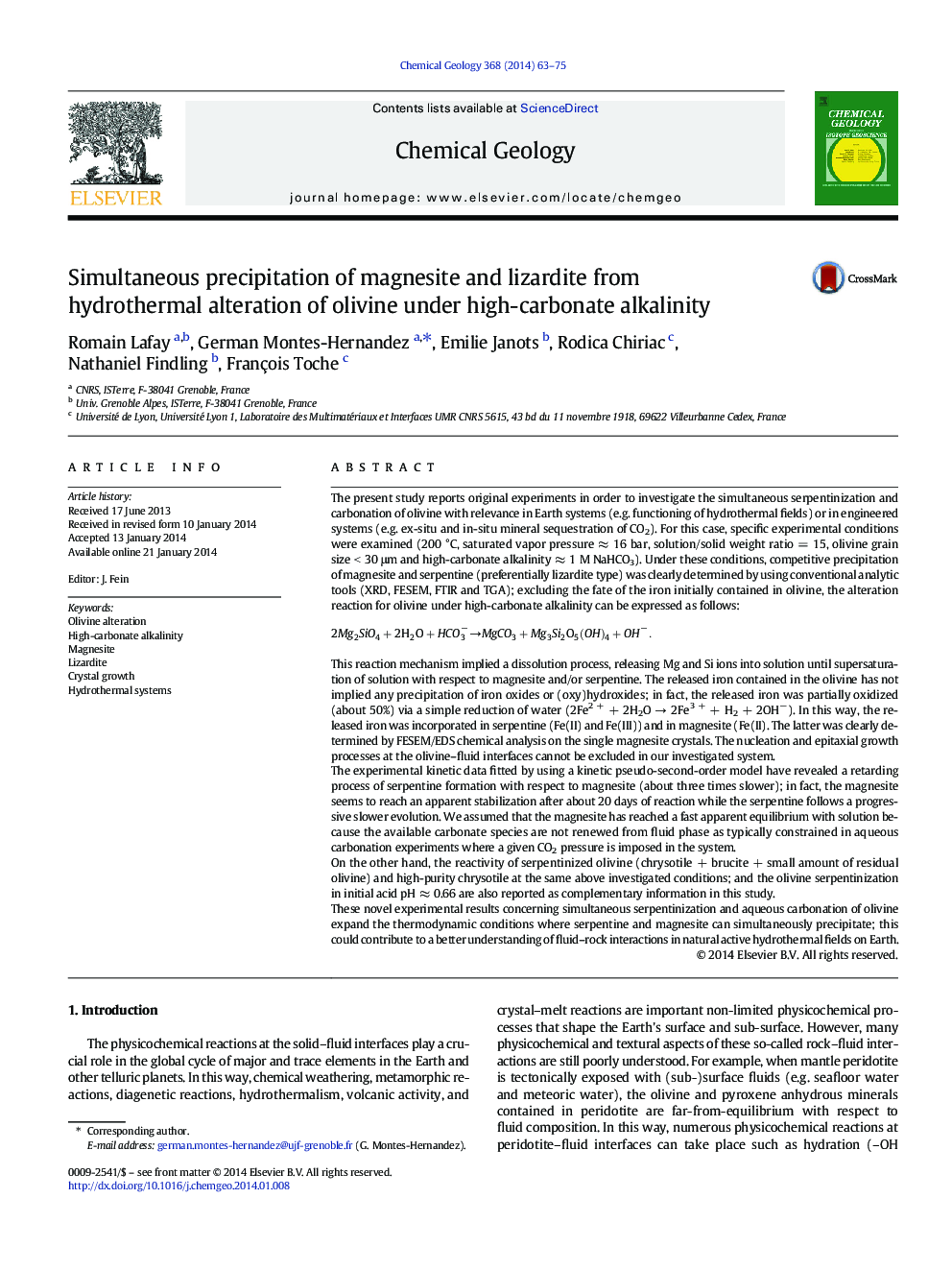| کد مقاله | کد نشریه | سال انتشار | مقاله انگلیسی | نسخه تمام متن |
|---|---|---|---|---|
| 4698834 | 1637602 | 2014 | 13 صفحه PDF | دانلود رایگان |
• New insights on the simultaneous serpentinization and carbonation of olivine
• Competitive precipitation of magnesite and serpentine were clearly determined.
• Olivine alteration has not implied any precipitation of Fe oxides/(oxy)hydroxides.
• Significant amount of released iron (Fe(II)) was incorporated in magnesite crystals.
The present study reports original experiments in order to investigate the simultaneous serpentinization and carbonation of olivine with relevance in Earth systems (e.g. functioning of hydrothermal fields) or in engineered systems (e.g. ex-situ and in-situ mineral sequestration of CO2). For this case, specific experimental conditions were examined (200 °C, saturated vapor pressure ≈ 16 bar, solution/solid weight ratio = 15, olivine grain size < 30 μm and high-carbonate alkalinity ≈ 1 M NaHCO3). Under these conditions, competitive precipitation of magnesite and serpentine (preferentially lizardite type) was clearly determined by using conventional analytic tools (XRD, FESEM, FTIR and TGA); excluding the fate of the iron initially contained in olivine, the alteration reaction for olivine under high-carbonate alkalinity can be expressed as follows:2Mg2SiO4+2H2O+HCO3−→MgCO3+Mg3Si2O5OH4+OH−.This reaction mechanism implied a dissolution process, releasing Mg and Si ions into solution until supersaturation of solution with respect to magnesite and/or serpentine. The released iron contained in the olivine has not implied any precipitation of iron oxides or (oxy)hydroxides; in fact, the released iron was partially oxidized (about 50%) via a simple reduction of water (2Fe2 + + 2H2O → 2Fe3 + + H2 + 2OH−). In this way, the released iron was incorporated in serpentine (Fe(II) and Fe(III)) and in magnesite (Fe(II). The latter was clearly determined by FESEM/EDS chemical analysis on the single magnesite crystals. The nucleation and epitaxial growth processes at the olivine–fluid interfaces cannot be excluded in our investigated system.The experimental kinetic data fitted by using a kinetic pseudo-second-order model have revealed a retarding process of serpentine formation with respect to magnesite (about three times slower); in fact, the magnesite seems to reach an apparent stabilization after about 20 days of reaction while the serpentine follows a progressive slower evolution. We assumed that the magnesite has reached a fast apparent equilibrium with solution because the available carbonate species are not renewed from fluid phase as typically constrained in aqueous carbonation experiments where a given CO2 pressure is imposed in the system.On the other hand, the reactivity of serpentinized olivine (chrysotile + brucite + small amount of residual olivine) and high-purity chrysotile at the same above investigated conditions; and the olivine serpentinization in initial acid pH ≈ 0.66 are also reported as complementary information in this study.These novel experimental results concerning simultaneous serpentinization and aqueous carbonation of olivine expand the thermodynamic conditions where serpentine and magnesite can simultaneously precipitate; this could contribute to a better understanding of fluid–rock interactions in natural active hydrothermal fields on Earth.
Journal: Chemical Geology - Volume 368, 12 March 2014, Pages 63–75
